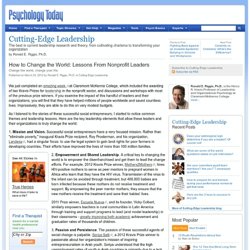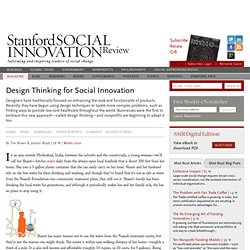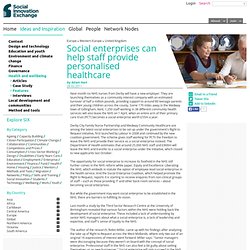

Creativity in the Non-Profit Sector. The Nonprofit Business Model Canvas. The Nonprofit Business Model Canvas. By Grant Smith The nonprofit is unique among businesses.

A regular for-profit business has one main type of customer or client, one that receives products or services in exchange for payment. The business then uses the revenue to pay for administrative expenses, marketing, salaries, etc., and everything else production related. How to Change the World: Lessons From Nonprofit Leaders. We just completed an amazing week at Claremont McKenna College, which included the awarding of two Kravis Prizes for leadership in the nonprofit sector, and discussions and workshops with most of the previous prize winners.

If you examine the impact of this handful of leaders and their organizations, you will find that they have helped millions of people worldwide and saved countless lives. Impressively, they are able to do this on very modest budgets. As I listened to the stories of these successful social entrepreneurs, I started to notice common themes and leadership lessons. Here are the key leadership elements that allow these leaders and their organizations to truly change the world: Design Thinking for Social Innovation. Designers have traditionally focused on enhancing the look and functionality of products.

Recently, they have begun using design techniques to tackle more complex problems, such as finding ways to provide low-cost healthcare throughout the world. Businesses were the first to embrace this new approach—called design thinking—and nonprofits are beginning to adopt it too. In an area outside Hyderabad, India, between the suburbs and the countryside, a young woman—we’ll call her Shanti—fetches water daily from the always-open local borehole that is about 300 feet from her home.
Www.ideo.com/images/uploads/thoughts/2010_SSIR_DesignThinking.pdf. HCD Connect. Human-Centered Design Toolkit. For years, businesses have used human-centered design to develop innovative solutions.

Why not apply the same approach to overcome challenges in the nonprofit world? This project, funded by International Development Enterprise (IDE) as part of a grant from the Bill & Melinda Gates Foundation, sought to provide NGOs and social enterprises with the tools to do just that. IDEO, in collaboration with nonprofit groups ICRW and Heifer International, developed the HCD Toolkit to help international staff and volunteers understand a community’s needs in new ways, find innovative solutions to meet those needs, and deliver solutions with financial sustainability in mind. Download IDEO’s Human Centered Design Toolkit.
Their Human Centered Design Toolkit is a free innovation guide for NGOs and social enterprises.

Iluminacion natural con botellas de agua. Announcing Our New E-book: THE Big IDEA: Global Spread of Affordable Housing. Iqbal Quadir says mobiles fight poverty. Sanjay Pradhan: How open data is changing international aid. Peter Drucker on the social sector, 2005-03-21. Drucker's Contributions to Nonprofit Management. By Leslie Lenkowsky For most of his career, Peter F.

Drucker was renowned as an expert on business management, whose books and articles were widely read, and advice widely sought, by corporate leaders throughout the world. But late in his life, he turned his attention to the nonprofit world, writing a best-selling guide to running charitable groups and creating a foundation bearing his name to strengthen leadership in what he called the "social sector. " This shift is not as surprising as it might initially seem. Mr. Drucker, who died last week, was interested in nonprofit groups because he thought they played a key role in giving a purpose to modern societies, a task he felt that, despite their economic successes, businesses increasingly avoided.
Mr. "Behavior Architects" Tackle India's Social Problems. The bureaucrats running Mumbai’s suburban rail network had a problem: Commuters and people living and working close to train stations were taking shortcuts across the tracks.

This reckless behavior was causing 6,000 deaths in the metropolitan area every year. The transit authorities asked FinalMile, a local marketing consultant, to find a solution. FinalMile had experience in applying behavioral economics to sell consumer goods; the city hoped it could use similar techniques to save lives. Social Innovation eXchange. Luis von Ahn: Massive-scale online collaboration. Socialab. Social enterprise and meritocracy: watch out for the blindspots. Social enterprise network. Social enterprises can help staff provide personalised healthcare. Next month six NHS nurses from Derby will have a new employer.

They are launching themselves as a community interest company with an estimated turnover of half a million pounds, providing support to around 80 teenage parents and their young children across the county. Some 170 miles away in the Medway town of Gillingham, Kent, 1,250 staff working in 38 different community health services will also leave the NHS on 1 April, when an entire arm of their primary care trust (PCT) becomes a social enterprise worth £55m a year. Derby City Family Nurse Partnership and Medway Community Healthcare are among the latest social enterprises to be set up under the government's Right to Request initiative, first launched by Labour in 2008 and continued by the new coalition government.
The scheme gives staff working for PCTs the freedom to leave the NHS and provide their service as a social enterprise instead. Article from the Guardian's Social Enterprise network: